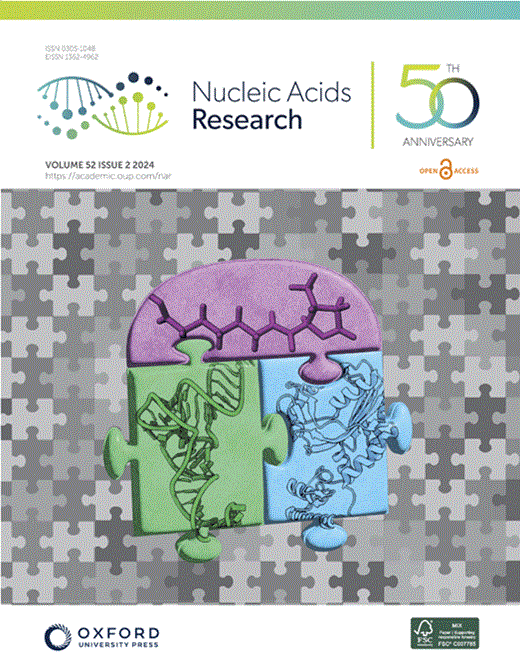MBNL 剪接因子调控骨骼肌的微转录组。
IF 16.6
2区 生物学
Q1 BIOCHEMISTRY & MOLECULAR BIOLOGY
引用次数: 0
摘要
肌盲剪接调节因子(MBNLs)控制着各种 RNA 处理步骤,包括替代剪接、多腺苷酸化、RNA 稳定性和 mRNA 细胞内定位。肌营养不良症 1 型(DM1)是成人中最常见的肌肉营养不良症,MBNLs 被封闭在含有扩展 CUG 重复序列的毒性 RNA 上,从而导致 MBNL 调节过程的中断和 DM1 的疾病特征。在本文中,我们展示了 MBNLs 在调节骨骼肌出生后发育过程中的微转录组动态以及在小鼠模型和 DM1 患者身上观察到的微 RNA(miRNA)失调中的重要作用。我们发现了对 MBNL 蛋白不足敏感的多种 miRNA,并揭示了其中许多 miRNA 在出生后受到调控,这与在此过程中这些蛋白的活性增加有关。在成年 Mbnl1 基因敲除小鼠中,miRNA 的表达呈现出从成年到新生儿的转变。我们推测,Mbnl1 缺乏会通过多种机制影响 miRNA 水平。首先,Mbnl1 蛋白的缺失会导致 pri-miRNA 水平的改变。其次,MBNLs 通过调节 miRNA 初级转录本的替代剪接来影响 miRNA 的生物发生。我们认为,由同一簇产生的 miR-23b、miR-27b 和 miR-24-1 的表达取决于含有 miRNA 序列的替代外显子对 MBNL 的敏感性。我们的研究结果表明,DM1 中的 MBNL 封闭是 miRNA 活性改变的部分原因。这项研究为了解 MBNL 蛋白作为骨骼肌中 miRNA 表达调控因子的生物学作用和功能提供了新的视角。本文章由计算机程序翻译,如有差异,请以英文原文为准。
MBNL splicing factors regulate the microtranscriptome of skeletal muscles.
Muscleblind like splicing regulators (MBNLs) govern various RNA-processing steps, including alternative splicing, polyadenylation, RNA stability and mRNA intracellular localization. In myotonic dystrophy type 1 (DM1), the most common muscular dystrophy in adults, MBNLs are sequestered on toxic RNA containing expanded CUG repeats, which leads to disruption of MBNL-regulated processes and disease features of DM1. Herein, we show the significance of MBNLs in regulating microtranscriptome dynamics during the postnatal development of skeletal muscles and in microRNA (miRNA) misregulation observed in mouse models and patients with DM1. We identify multiple miRNAs sensitive to MBNL proteins insufficiency and reveal that many of them were postnatally regulated, which correlates with increases in the activity of these proteins during this process. In adult Mbnl1-knockout mice, miRNA expression exhibited an adult-to-newborn shift. We hypothesize that Mbnl1 deficiency influences miRNA levels through a combination of mechanisms. First, the absence of Mbnl1 protein results in alterations to the levels of pri-miRNAs. Second, MBNLs affect miRNA biogenesis by regulating the alternative splicing of miRNA primary transcripts. We propose that the expression of miR-23b, miR-27b and miR-24-1, produced from the same cluster, depends on the MBNL-sensitive inclusion of alternative exons containing miRNA sequences. Our findings suggest that MBNL sequestration in DM1 is partially responsible for altered miRNA activity. This study provides new insights into the biological roles and functions of MBNL proteins as regulators of miRNA expression in skeletal muscles.
求助全文
通过发布文献求助,成功后即可免费获取论文全文。
去求助
来源期刊

Nucleic Acids Research
生物-生化与分子生物学
CiteScore
27.10
自引率
4.70%
发文量
1057
审稿时长
2 months
期刊介绍:
Nucleic Acids Research (NAR) is a scientific journal that publishes research on various aspects of nucleic acids and proteins involved in nucleic acid metabolism and interactions. It covers areas such as chemistry and synthetic biology, computational biology, gene regulation, chromatin and epigenetics, genome integrity, repair and replication, genomics, molecular biology, nucleic acid enzymes, RNA, and structural biology. The journal also includes a Survey and Summary section for brief reviews. Additionally, each year, the first issue is dedicated to biological databases, and an issue in July focuses on web-based software resources for the biological community. Nucleic Acids Research is indexed by several services including Abstracts on Hygiene and Communicable Diseases, Animal Breeding Abstracts, Agricultural Engineering Abstracts, Agbiotech News and Information, BIOSIS Previews, CAB Abstracts, and EMBASE.
 求助内容:
求助内容: 应助结果提醒方式:
应助结果提醒方式:


